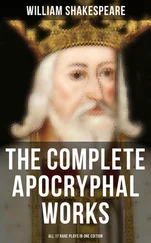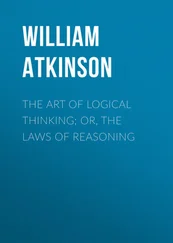This axiom has been stated in various terms other than those stated above. For instance: "Whatever may be affirmed or denied of the whole, may be denied or affirmed of the parts;" which form is evidently derived from that used by Hamilton who said: "What belongs, or does not belong, to the containing whole, belongs or does not belong, to each of the contained parts." Aristotle formulated his celebrated Dictum as follows: "Whatever can be predicated affirmatively or negatively of any class or term distributed, can be predicated in like manner of all and singular the classes or individuals contained under it."
There is another form of Deductive Reasoning, that is a form based upon another axiom than that of: "Whatever is true of the whole is true of the parts." This form of reasoning is sometimes called Mathematical Reasoning, because it is the form of reasoning employed in mathematics. Its axiom is stated as follows: "Things which are equal to the same thing, are equal to one another." It will be seen that this is the principle employed in mathematics. Thus: "x equals y; and y equals 5; therefore, x equals 5." Or stated in logical terms: "A equals B; B equals C; therefore, A equals C." Thus it is seen that this form of reasoning, as well as the ordinary form of Deductive Reasoning, is strictly mediate , that is, made through the medium of a third thing, or "two things being compared through their relation to a third."
Brooks states: "The real reason for the certainty of mathematical reasoning may be stated as follows: First, its ideas are definite, necessary, and exact conceptions of quantity. Second, its definitions, as the description of these ideas are necessary, exact, and indisputable truths. Third, the axioms from which we derive conclusions by comparison are all self-evident and necessary truths. Comparing these exact ideas by the necessary laws of inference, the result must be absolutely true. Or, stated in another way, using these definitions and axioms as the premises of a syllogism, the conclusion follows inevitably. There is no place or opportunity for error to creep in to mar or vitiate our derived truths."
In conclusion, we wish to call your attention to a passage from Jevons which is worthy of consideration and recollection. Jevons says: "There is a simple rule which will enable us to test the truth of a great many arguments, even of many which do not come under any of the rules commonly given in books on logic. This rule is that whatever is true of one term is true of any term which is stated to be the same in meaning as that term . In other words, we may always substitute one term for another if we know that they refer to exactly the same thing . There is no doubt that a horse is some animal, and therefore the head of a horse is the head of some animal. This argument cannot be brought under the rules of the syllogism, because it contains four distinct logical terms in two propositions; namely, horse, some animal; head of horse, head of some animal. But it easily comes under the rule which I have given, because we have simply to put 'some animal' instead of 'a horse'. A great many arguments may be explained in this way. Gold is a metal; therefore a piece of gold is a piece of metal. A negro is a fellow creature; therefore, he who strikes a negro, strikes a fellow creature."
The same eminent authority says: "When we examine carefully enough the way in which we reason, it will be found in every case to consist in putting one thing or term in place of another, to which we know it to have an exact resemblance in some respect . We use the likeness as a kind of bridge, which leads us from a knowledge of one thing to a knowledge of another; thus the true principle of reasoning may be called the substitution of similars, or the passing from like to like . We infer the character of one thing from the character of something which acts as a go-between, or third term. When we are certain there is an exact likeness, our inference is certain; when we only believe that there probably is, or guess that there is, then our inferences are only probable, not certain."
CHAPTER XVI.
THE SYLLOGISM
Table of Content
The third and highest phase or step in reasoning—the step which follows after those styled Conception and Judgment—is generally known by the general term "Reasoning," which term, however, is used to include the two precedent steps as well as the final step itself. This step or process consists of the comparing of two objects, persons or things, through their relation to a third object, person or thing. As, for instance, we reason (a) that all mammals are animals; (b) that a horse is a mammal; and (c) that, therefore , a horse is an animal. The most fundamental principle of this step or reasoning consists in the comparing of two objects of thought through and by means of their relation to a third object. The natural form of expression of this process of reasoning is called a "Syllogism."
The process of reasoning which gives rise to the expression of the argument in the form of a Syllogism must be understood if one wishes to form a clear conception of the Syllogism. The process itself is very simple when plainly stated, although the beginner is sometimes puzzled by the complicated definitions and statements of the authorities. Let us suppose that we have three objects, A, B and C, respectively. We wish to compare C and B, but fail to establish a relation between them at first. We however are able to establish a relation between A and B; and between C and A. We thus have the two propositions (1) "A equals B; and (2) C equals A". The next step is that of inferring that "if A equals B, and C equals A, then it must follow, logically, that C equals B ." This process is that of indirect or mediate comparison, rather than immediate . C and B are not compared directly or immediately, but indirectly and through the medium of A. A is thus said to mediate between B and C.
This process of reasoning embraces three ideas or objects of thought, in their expression of propositions. It comprises the fundamental or elemental form of reasoning. As Brooks says: "The simplest movement of the reasoning process is the comparing of two objects through their relation to a third." The result of this process is an argument expressed in what is called a Syllogism. Whately says that: "A Syllogism is an argument expressed in strict logical form so that its conclusiveness is manifest from the structure of the expression alone, without any regard to the meaning of the terms." Brooks says: "All reasoning can be and naturally is expressed in the form of the syllogism. It applies to both inductive and deductive reasoning, and is the form in which these processes are presented. Its importance as an instrument of thought requires that it receive special notice."
In order that the nature and use of the Syllogism may be clearly understood, we can do no better than to at once present for your consideration the well-known "Rules of the Syllogism," an understanding of which carries with it a perfect comprehension of the Syllogism itself.
The Rules of the Syllogism state that in order for a Syllogism to be a perfect Syllogism, it is necessary:
I. That there should be three, and no more than three, Propositions. These three propositions are: (1) the Conclusion , or thing to be proved; and (2 and 3) the Premises, or the means of proving the Conclusion, and which are called the Major Premise and Minor Premise, respectively. We may understand this more clearly if we will examine the following example:
Major Premise : "Man is mortal;" (or "A is B").
Minor Premise : "Socrates is a man;" (or "C is A"). Therefore:
Conclusion : "Socrates is mortal" (or "C is B").
Читать дальше












